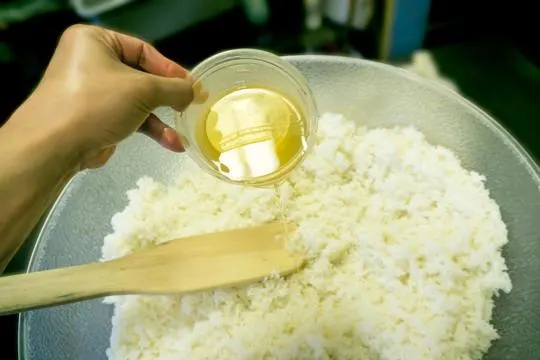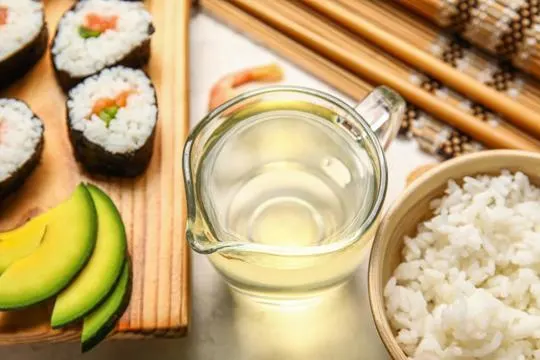Rice vinegar and mirin may sound like distant cousins at a family reunion. One’s tart and tangy, the other’s sweet as your grandma’s compliments. Know your players in the kitchen game.
We’ve all been there, staring at our pantry. Thinking rice vinegar could totally sub in for mirin. Spoiler alert: it can’t. Our dishes showed us the truth the hard way.
Rice vinegar brightens your sushi rice. Mirin? It’s the secret behind that glaze on your fave teriyaki chicken. Two different vibes, folks.
We’re here sharing our kitchen mishaps so you don’t have to. Learn from us. Rice vinegar and mirin? Not interchangeable. Your taste buds will thank you.
What is Rice Vinegar?

Rice vinegar is a special type of vinegar.
It’s made from fermented rice and has a light, sweet flavor.
This vinegar adds a tangy taste to many dishes, like dressings, marinades, and sauces.
It’s unique because it’s available in three different varieties – white, black, and red.
White rice vinegar is the most common.
Black is stronger in flavor, and goes great with rich, savory meals.
Red rice vinegar has a fruity flavor.
In addition to taste, rice vinegar offers some health benefits.
It has acetic acid, which helps you digest food and balance blood sugar levels.
Plus, it’s low in calories and fat-free.
Overall, rice vinegar is a great ingredient for enhancing flavor.
Its tangy and sweet taste adds depth to salads, stir-fries, and even desserts.
Use it as a dressing or a marinade to bring a delightful touch to your cooking.
Try experimenting with different varieties to bring exciting new dimensions to your recipes.
What is Mirin?

Mirin is a traditional Japanese cooking wine.
It’s made by fermenting glutinous rice with koji mold and alcohol.
The mix gives a sweet and tangy liquid.
It’s used in marinades, glazes, and sauces.
This cooking wine has been around for centuries.
It brings out the natural flavors of ingredients without overpowering them.
It’s perfect for balancing salty or savory flavors.
Mirin may have health benefits.
It has antioxidants that protect cells and reduce inflammation.
It may also help with digestion and blood sugar control.
There are different types of mirin.
Hon-mirin is the best quality.
Shio-mirin is higher in salt and sugar.
Non-alcoholic and alcohol-free substitutes are available.
Differences Between Rice Vinegar and Mirin

Rice vinegar and mirin. Two staples of Asian cuisine.
But, they’re different.
Ingredients Used
Cooking involves choosing ingredients that greatly influence the taste and flavor.
This article looks into the two popular ingredients: rice vinegar and mirin.
Rice vinegar is made from fermented rice.
It has a mild and sweet taste, so it is great for many Asian dishes.
For example, sushi rice, pickles, and marinades all use rice vinegar.
This ingredient provides a light flavor to the other ingredients.
Mirin is a Japanese condiment.
It is made from sweet rice and has a higher sugar content.
Therefore, it has a sweeter flavor than rice vinegar.
Mirin adds depth and complexity to sauces, glazes, and stir-fries.
Though both ingredients are used in Asian cuisine, they serve different purposes.
Rice vinegar is an acidifier and flavor enhancer.
Mirin adds sweetness and richness.
Choose between the two depending on the dish.
Rice vinegar adds tanginess without sweetness.
Mirin brings sweetness and richness.
New flavors can be found by experimenting with both ingredients.
Flavor Profile
Rice vinegar and mirin look akin, yet their flavorings are distinct.
Rice vinegar has a tangy taste, a tinge of sweetness, and a mild acidic flavor.
It adds a refreshing touch to salads and pickles.
Mirin, on the other hand, has a special flavor that is both sweet and slightly alcoholic.
It enhances marinades and sauces, by balancing out savory flavors.
Popular in Japanese cuisine.
Rice vinegar is made from fermented rice or wine.
It goes through fermentation, turning sugar into alcohol, then acetic acid.
The acidity varies, depending on production.
Mirin is made from glutinous rice, koji mold, distilled spirits (e.g. shochu or sake), and sugar.
It has 14-15% alcohol content, yet the sugar hides the alcohol flavor.
To sum up, rice vinegar and mirin offer different flavor boosts.
Knowing these differences helps cooks pick the right ingredient for the desired taste.
No more confusion about which bottle to grab from the pantry.
Usage in Cooking
Rice vinegar and mirin may seem similar, but they have different uses in cooking.
Rice vinegar is often used for pickling and adding acidity to dishes.
Mirin, on the other hand, is a sweet rice wine that adds mild sweetness and depth of flavor.
In Japanese cuisine, rice vinegar is added to sushi rice, dressings, marinades, and dipping sauces.
Its acidity helps enhance the taste of vegetables and add freshness to stir-fries.
It can also be substituted for other vinegars or citrus juice.
Mirin, however, plays a different role.
It contains alcohol from fermentation.
Its primary characteristic is its natural sweetness, which helps glazes caramelize and provides a pleasant aroma.
Mirin is commonly found in teriyaki sauces, braised dishes, and simmered meats.
It gives dishes a glossy appearance and tenderizes proteins, while imparting its unique flavor.
What sets mirin apart from other sweeteners is its complexity of taste.
It adds depth to sauces without excessive sweetness.
Mirin is also a natural preservative due to its alcohol content.
Rice vinegar and mirin are both key ingredients in Japanese cooking.
Rice vinegar adds acidity and brightness, while mirin adds subtle sweetness and complexity of flavor.
How you use them can make all the difference in the flavor of your dishes.
Sweetness Level
Rice vinegar and mirin, both used in cooking, are quite different.
Rice vinegar has a tangy flavor, with a subtle sweetness that adds flavor to dishes.
Mirin however, is sweeter due to its higher sugar content.
Rice vinegar is the perfect balance of sour and sweet.
Its mild acidity makes it great for dressings, marinades, and pickling veggies.
The sweetness of rice vinegar brings out the natural taste of savory dishes.
Mirin takes sweetness to a new level.
It’s made from fermented rice and has a higher sugar content than rice vinegar.
It offers a distinctively sweet flavor that intensifies when cooked or heated, making it common in teriyaki sauces and glazes.
The sweetness of rice vinegar and mirin serve different purposes in cooking.
Rice vinegar offers a hint of sweetness along with its tanginess, while mirin delivers a more pronounced sweet taste.
Choosing depends on desired flavor and dish.
In conclusion, the difference in sweetness between rice vinegar and mirin lies in their flavors and sugar contents.
Rice vinegar adds a mellow sweetness while accentuating other tastes, and mirin provides a burst of sugary richness that enhances the overall flavor.
Knowing these nuances allows for better use of these ingredients in culinary creations.
Similarities Between Rice Vinegar and Mirin

Rice vinegar and mirin share similarities, such as their use in Asian cuisine and sweet/tangy flavor profile.
They are both made from rice, but the fermentation process differs.
Rice vinegar is fermented with yeast/bacteria, while mirin has koji (fungus) and steamed glutinous rice, then ferments for months.
Both ingredients add complexity/depth to dishes, making them essential.
Sometimes, they can be used interchangeably, though it’s important to note that mirin has more sugar, which makes dishes sweeter.
Rice vinegar has stronger acidity, so it may make the flavor more tart.
Chefs must understand both ingredients’ nuances to make informed choices.
Rice vinegar and mirin may share similarities, but their unique flavors/sweetness/acidity make them suitable for different culinary applications.
By understanding these differences, chefs can use the versatility of both to elevate the taste of their dishes.
How to Use Rice Vinegar and Mirin in Cooking?
To cook with rice vinegar and mirin, one must comprehend their special traits.
Rice vinegar has a tangy, slightly sweet taste and is often used in dressings, marinades, and sushi rice.
Its tartness adds a bright flavor without overpowering other tastes.
Mirin, a sweet rice wine, brings a gentle sweetness to sauces, glazes, and soups.
It not only perks up the flavor but also gives ingredients a glossy glaze.
Both rice vinegar and mirin fulfill different roles in cooking but bring out the best of each dish’s flavor.
Popular Brands of Rice Vinegar and Mirin
Rice vinegar and mirin are two popular condiments in Asian cuisine.
They each bring distinct flavors to dishes.
Let’s explore some renowned brands offering these essential elements.
Marukan provides premium quality rice vinegar.
Its mild flavor and delicate sweetness make it perfect for various recipes.
Nakano is another popular brand, offering seasoned, organic, and natural rice vinegars.
When it comes to mirin, Kikkoman is the go-to choice.
It offers an authentic taste with its rich and sweet variety.
Other brands like Mizkan also offer high-quality options.
For those seeking a gluten-free option, Eden Foods has organic rice vinegars.
Takara Shuzo produces mirin with traditional brewing methods and a full-bodied taste.
Rice vinegar and mirin can elevate the taste of dishes.
Explore different brands for diverse flavors and new culinary dimensions.
So go ahead and enhance your Asian-inspired creations.
Conclusion
Rice vinegar has a tangy, sour flavor.
It’s great for dressings, marinades, and pickling.
Mirin on the other hand, is a sweet wine with a subtle umami taste.
It adds depth to sauces, glazes, and soups.
If you want to avoid the alcohol content, rice vinegar can be used as a replacement for mirin in cooking.
However, the flavor will be slightly different.
Mirin can’t be replaced as it brings a unique sweetness.
Mirin should be used in small quantities due to its intense sweetness.
It balances flavors without overpowering the dish.
Rice vinegar can be used more freely, without fear of it being too acidic.
In conclusion, rice vinegar and mirin are both made from fermented rice, but have different flavors and uses.
It depends on the taste profile and recipe which one you choose.

Leave a comment